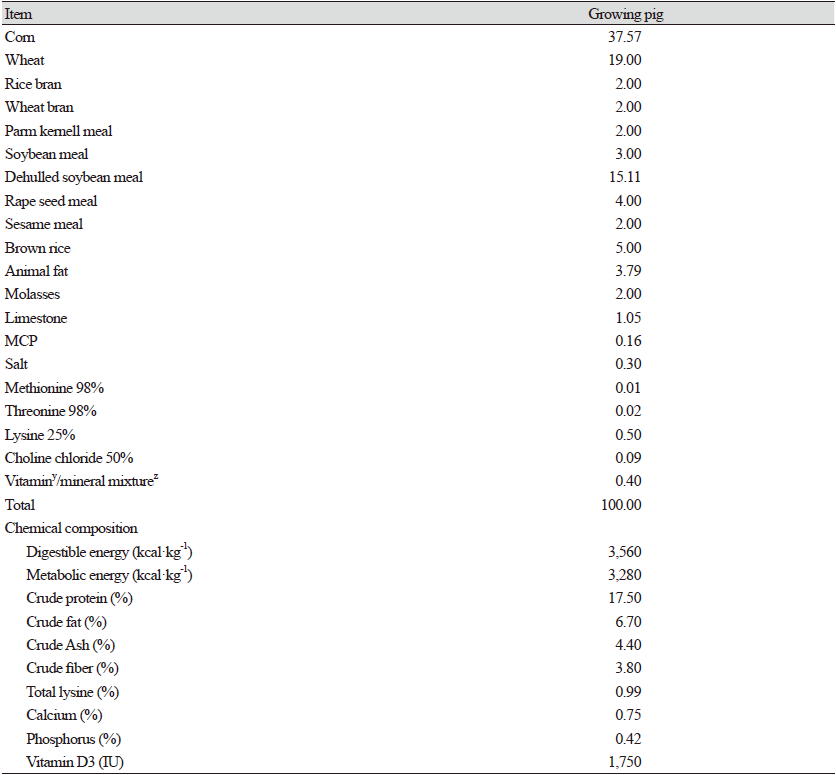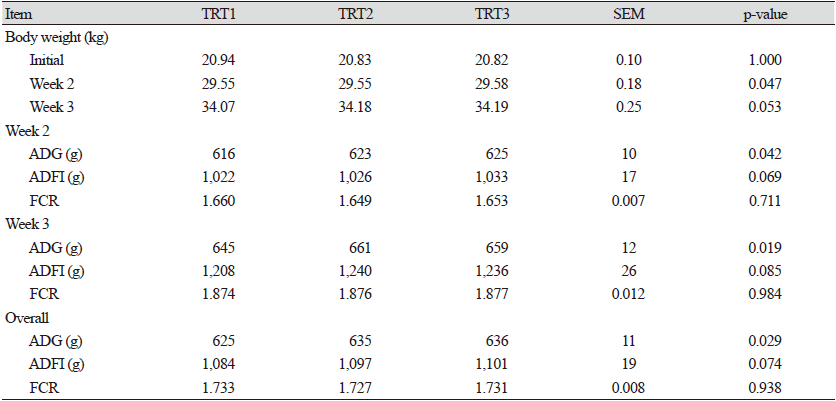Introduction
Modern animal husbandry imposes a variety of stress conditions that are associated with a negative impact on the physiological, immune, and biological properties of the gastrointestinal tract. These stress factors lead to stunted growth, reduced food intake and gastrointestinal disorders. Antibiotics are widely used as growth promoters in pig production to alleviate these negative challenges. However, nowadays the use of antibiotics growth promoters (AGP) in the livestock industry is widely criticized because of the potential health risk to animals and consumers due to antibiotic resistance (Liu et al., 2018). Thereby, use of antibiotics in livestock diets has been banned in the EU since 2003 (Huang et al., 2010). In addition, eliminating AGP in animal feed creates enormous economic losses (Bai et al., 1999). All of these risks’ factors trigger researchers to find a viable alternative to AGP. There has been considerable interest in evaluating the effect of mineral supplements as growth promoters in livestock and poultry diets over the past few years (Hong et al., 2004; Cho et al., 2006).
Zinc oxide (ZnO) has been widely used in diets of weaning pigs since, 20th century and it is considered as the second most abundant transition metal in biological systems (Suhy et al., 1999). Though Zn acts as a growth promoter, it (heavy metal) was considered as toxic when used in high concentrations. Thus, European countries allowed the addition of ZnO as additive at maximum concentration of 150 - 200 mg·kg-1 in animals feed by considering the safety of animals as well as consumers. Previously many researcher demonstrated that feeding high concentrations of ZnO had reduce diarrhea incidences and developed growth efficiency of piglets (Grela and Pastuszak, 2004; Cho et al., 2011). In addition, Oropeza-Moe et al. (2017) stated that use of 3,000 ppm Zn from ZnO in weanling diets has promote growth performance and decreased the incidence of diarrhea. Similarly, Case and Carlson (2002) stated that weaning pigs’ fed pharmacological dosage (2,000 - 3,000 ppm) of ZnO had increased average daily gain (ADG) and reduced the incidence of post-weaning scouring, and developed the immunity. Moreover, Yin et al. (2009) noted that dietary inclusion of Zn had stimulate the feed intake perhaps by increasing the ghrelin secretion of pigs.
In 1934, Todd et al. stated that zinc (Zn) was an important nutrient trace element that promotes the growth and health of laboratory animals. Furthermore, Morales et al. (2012) noted that dietary supplementation with 110 ppm of ZnO has significantly improved the growth performance of piglets on days 42 to 63. Nagalakshmi et al. (2012) demonstrated that the dietary supplement with zinc has improved body weight of rat during 4th week. We hypothesized that dietary supplementing 0.07% (or) 1% ZnO to the diet of growing pigs could be enhance the growth performance and reduce the fecal score. The focal aim of this study was to determine the ZnO supplementation on growth efficiency, total tract digestibility, and fecal score in growing pigs.
Materials and Methods
The experiment was carried out by following the ethics of Animal Care and Use Committee of Dankook University, at Cheonan, Chungnam, South Korea (DK-1-1933).
The growing pig trial was carried out for three weeks at Dankook University “Intensive pig farm” (Cheonan, Korea) with eighty-four crossbred ([Landrace Yorkshire] × Duroc) growing pigs. At first, pigs were selected and divided on the basis of gender and body weight (BW) (initial 20.86 ± 0.64 kg), then they were housed in steel cages (complete random block) with pleasant environment. Trial room temperature was maintained at 30℃, Self-feeder and nipple drinker was fixed in the corner of all cages which allowed pigs to enjoy free access of feed and water throughout the trial.
Pigs were randomly assigned into one of three treatments (4 pigs per pen [2 gilts and 2 barrows]; 7 pens per treatments) in a complete randomized block design. The dietary treatments were as: TRT1 (CON [basal diet]); TRT2 (CON + 0.07% ZnO); TRT3 (CON + 1% ZnO). All nutrients in diets were formulated to meet or exceed the recommendation of NRC (2012) for growing pigs and fed in mash form (Table 1). The dietary supplement ZnO (125 - 250 g·ton-1) used in this present study was commercially obtained from Farmsco, Co., Ltd. (Anseong, Korea) and the active ingredients of ZnO supplement were 17.50% crude protein, 3.80% crude fiber, and 0.99% total lysine. Basal diet and ZnO supplements were mixed using feed mixer DDK-801 (Daedong Tech, Gyeongsan, Korea).
The dietary ZnO supplements were offered to growing pigs for 21 days. At initial, week 2 and week 3 the amount of feed consumption and residual was weighed and recorded to evaluate the feed intake. On week 2, week 3, and overall average daily gain (ADG), average daily feed intake (ADFI), and feed conversion ratio (FCR) were calculated by the collected data. In order to measure the total tract digestibility of dry matter (DM), nitrogen (N), and energy, 0.20% chromium oxide was added to the diet as an indigestible marker for 7 days prior to fecal collection at end of experiment. These analyses were carried out according to the guidelines of AOAC (2000). Fecal samples were collected randomly from at least 2 pigs (1 barrow and 1gilt) per pen then pooled with representative sample and stored in a freezer at -20℃. All feed and fecal samples were freeze-dried and finely ground to pass through a 1 mm screen. DM and N digestibility were determined using methods established by the Association of Official Analytical Chemists (AOAC, 2000). UV absorption spectrophotometry (UV-1201, Shimadzu, Kyoto, Japan) was used to determine chromium in the diets and feces at the same time Parr 6100 oxygen bomb calorimeter (Parr Instrument Co., Moline, IL, USA) was used to analyze energy by measuring the heat of combustion in the samples. The calculation of total tract digestibility formula was used according to Sales and Janssens (2003).
Fecal score was evaluated and recorded from day 1, 7, 14, and 21 respectively. The average value of 5 pigs (each pen) fecal score was determined by the methods of Hu et al. (2012) 5-grade score system. The score systems were as follows 1 = hard, dry pellets in a small, hard mass; 2 = hard, formed stool which remains firm and soft; 3 = soft, formed and moist stool which retains its shape; 4 = soft, shapeless stool that assumes the shape of the container; 5 = watery, liquid stool that can be poured. Fecal grade scores were recorded on a pen basis by observing individual pig signs of stool consistency in pen.
Statistical analysis
All data were analysed as a randomised complete block design and the ANOVA was conducted using the GLM procedure of SAS/STATVR 9.2 (SAS Inst. Inc., Cary, NC, USA). For all response criteria, each pen served as the experimental unit. Variability in the data was expressed as the standard errors mean. Differences among treatment means were determined using Tukey’s range test. (p< 0.05) indicates significance and p < 0.10 was considered as a trend.
Results and Discussion
Current grower pig feeding guidelines are based on research using factorial methods to approximate the Zn demand of pigs during the development cycle (NRC, 2012). Previously Cho et al. (2015) demonstrated that 2,000 - 3,000 ppm high concentration of ZnO supplementation had enhanced growth performance of piglets. In addition, Mavromichalis et al. (2000) reported that dietary inclusion of pharmacological dose of ZnO in weaning pigs’ diet had improved growth performance during post weaning period (first two weeks). In the present study, dietary inclusion of ZnO supplementation had significantly enhanced grower pigs BWG (p = 0.047, 0.054) at week 2, and 3. In addition, significant effects were observed on ADG during week 2, week 3, and over all experiment (p = 0.042, 0.019, and 0.029 respectively) tendency effects on ADFI was also observed with increasing level of ZnO. However, ZnO supplementation has failed to affect FCR of growing pigs during entire experiment (Table 2). This result is agreed with Pei et al. (2019) who found improved growth performance in weaned pigs supplement with ZnO supplementation. Similarly, Case and Carlson (2002) stated that feeding 3,000 ppm inclusion of ZnO supplementation enhanced nursery pigs growth performance. Wei et al. (2020) demonstrated that increasing level of peptide combination with ZnO supplementation tended to control the pig’s immune system and stress levels. This allowed pigs to distribute dietary nutrients rather than proinflammatory responses to weight gain. To our knowledge, there is limited information presented on the ZnO in growing pigs’ diet. However, the improved growth performance can be due to the enhanced conditions of intestinal lumen because of the beneficial influence of the ZnO on the intestinal micro flora, which is manifested in the total nutrient digestibility.
The total tract digestibility of DM, and N was significantly improved in pigs fed ZnO supplementation (p = 0.032, 0.044) without effect on energy compared to control (Table 3), this finding was correlated with a previous study of Chrastinová et al. (2016) who found a significant improved nutrient digestibility of rabbits fed with (170 mg·kg-1) Zn compare to control treatment. Similarly, Vallee and Falchuk (1993) demonstrated Zn plays an important function in the synthesis of sugars, lipids and proteins for energy consumption released from digestion of feeds. In contrast, Shinde et al. (2006) stated that inclusion of 20 ppm level organic Zn supplementation had not affected digestibility of crude protein in guinea pigs and broiler supplemented with 10 - 30 ppm level (Sridhar et al., 2015). The lack of our results may be due to the difference in ZnO dosage level or animal’s age. Liu et al. (2018) stated that the increased villus height and decreased crypt depth which has been associated with effective nutrient absorption and beneficial growth performance. However, in the present study did not measure the intestinal morphology. Nutrient digestibility is the extent to which feed nutrients are absorbed as they pass through swine digestive tract (Thamaraikannan and Kim, 2021). Therefore, we believe that dietary inclusion of ZnO supplementation has been shown to improve growth performance and nutrient digestibility of growing pigs.
Zinc is an excellent source of diarrhea preventing agent, but it is very harmful to the environment when used in high doses (Cho et al., 2015). The fecal score was reduced (p = 0.04) in pigs fed ZnO supplementation at initial was illustrated in Table 4. However, week 2, and 3 fecal score was not affected growing pigs fed with ZnO supplementation. This was correlated with the findings of Cho et al. (2015) who stated that fecal score was significantly reduced by the addition Zn supplementation on weaning pigs during days 1, 14, 35, and 42. Likewise, Carlson et al. (2008) stated that high concentration of ZnO has reduced the diarrhea rate in weaning pig. Similarly, Chang et al. (2020) also observed reduced diarrhea incidence in calves which fed Zn supplementation during the first 14 d after birth. Huang et al. (1999) observed that the decreased number of bacteria accessing the ileal mesenteric lymph nodes of weaner pigs when combined with 3,000 ppm ZnO.
Conclusion
The current study will be the base for further research. the dietary inclusion of zinc oxide supplementing in the growing pigs diet had a positive effect on the growth performance, apparent total digestibility, and fecal score. On other hand, further research is need for various standards of dietary zinc oxide to understand the effect of zinc oxide in grower-finisher pigs.










